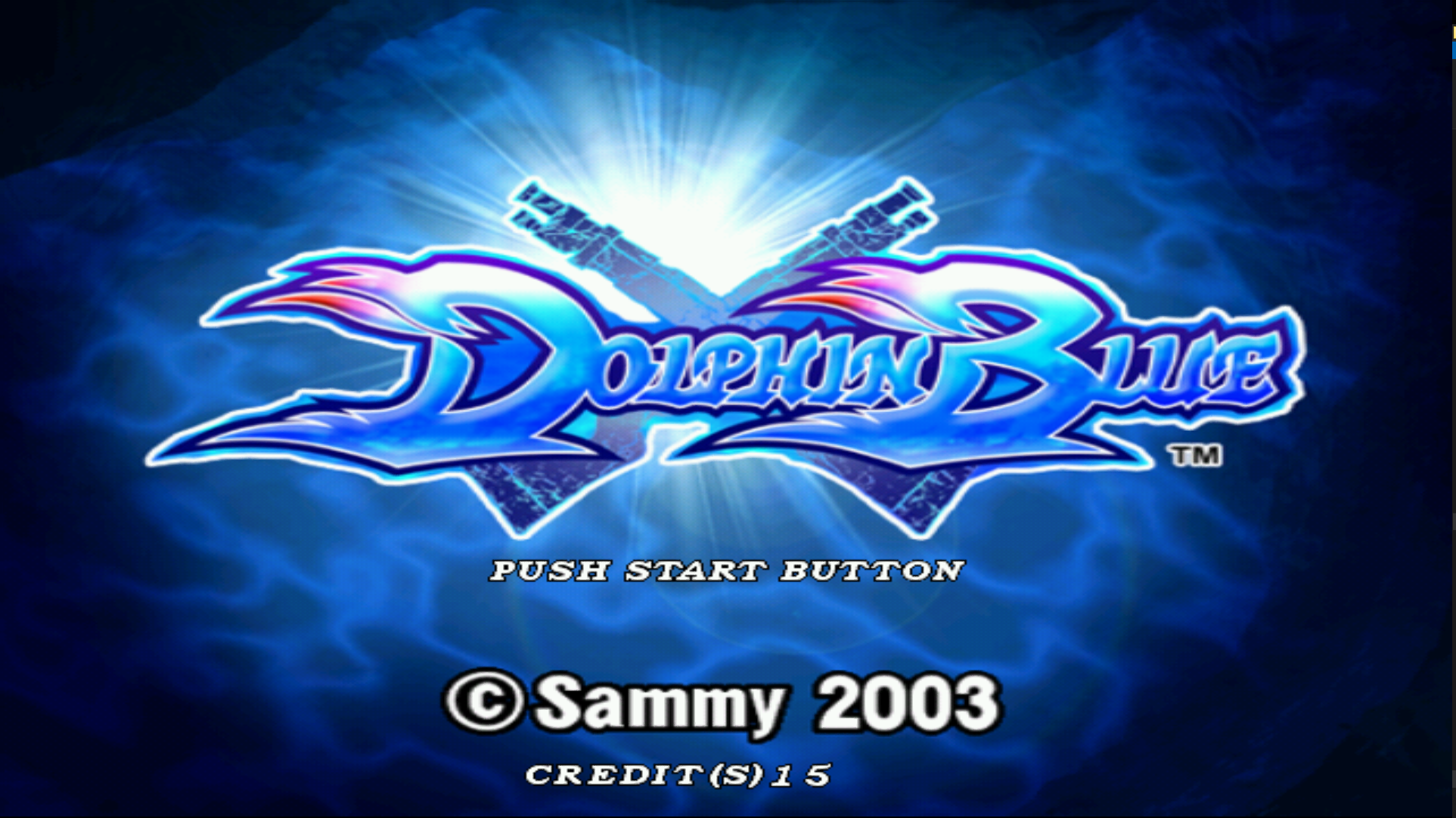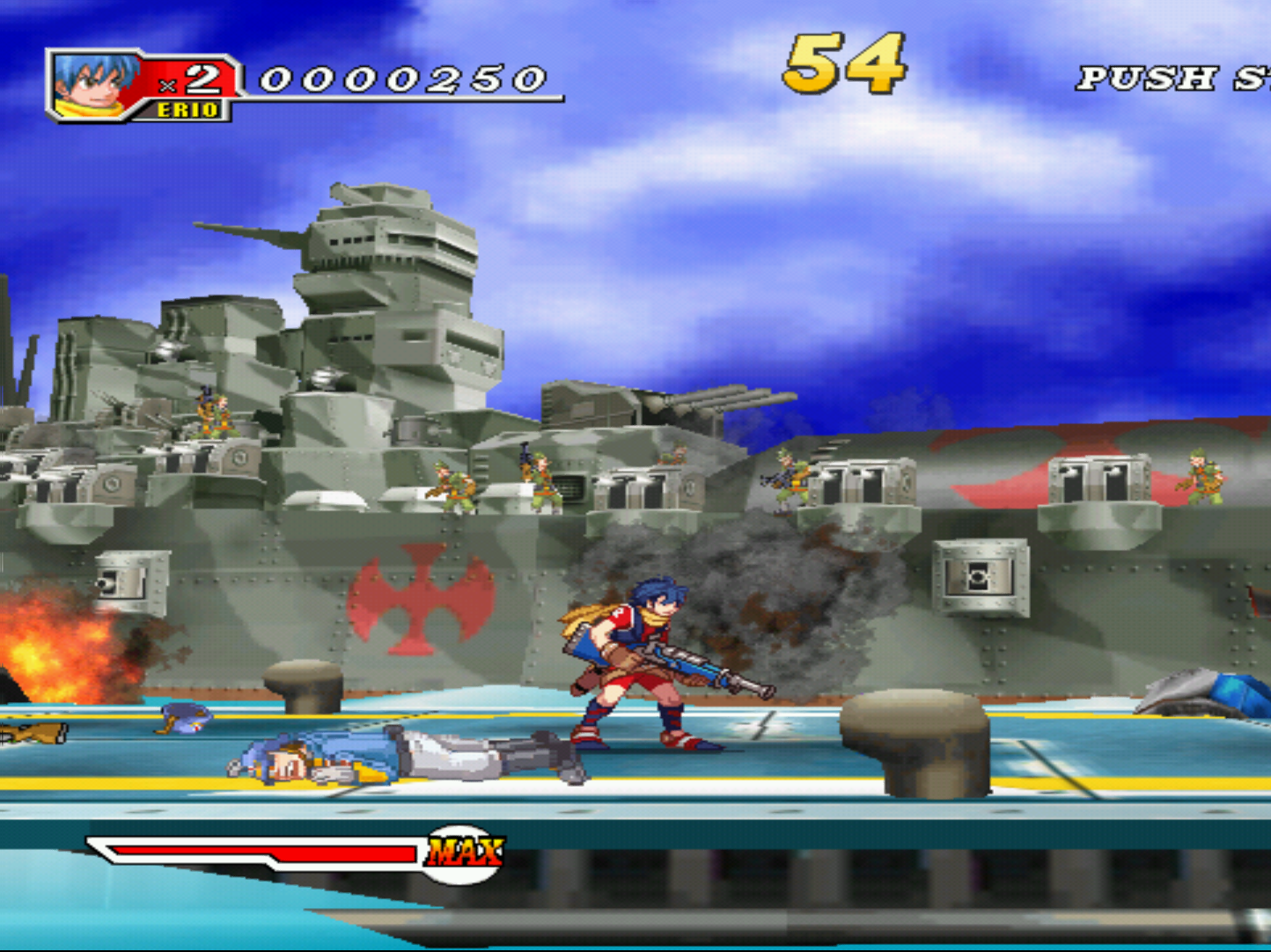If you’re a fan of fast-paced, side-scrolling shooters with a dash of quirky charm, Dolphin Blue might just be one of the coolest retro games you’ve never heard of or played. Released in 2003 by Sammy Corporation, this obscure title flew under the radar for most gamers, overshadowed by giants like Metal Slug—a series it clearly draws inspiration from. But don’t let its lack of fame fool you: Dolphin Blue is a vibrant, dolphin-riding, action-packed adventure that deserves a spot in the retro gaming hall of fame. Here’s why it’s worth your attention, a look at its history, the platforms it graced, and how you can play it today using a Sammy Atomiswave emulator.
Why Dolphin Blue Stands Out
Imagine a world where the Earth’s landmasses have sunk beneath the waves, and humanity clings to survival on scattered islands. In this flooded future called “Aquadia,” you step into the shoes (or fins?) of either Erio, a thrill-seeking arms dealer, or Anne, a noble Royal Army soldier. Your mission? Take down the Evil Empire with the help of your trusty dolphin companion. Yes, you read that right—you ride a dolphin into battle, blasting enemies with an arsenal of weapons in a style reminiscent of Metal Slug, but with a unique aquatic twist.
What makes Dolphin Blue so cool is its blend of high-energy gameplay and eye-popping visuals. The game boasts a mix of crisp 2D sprites and subtle 3D effects, giving it a polished look that was ahead of its time for 2003. The stages alternate between land and underwater sequences, keeping the action dynamic, while your dolphin adds a layer of personality—leaping into the fray for special attacks or helping you navigate the chaos. It’s Metal Slug meets Ecco the Dolphin, with a hefty dose of arcade flair. The soundtrack pumps you up, the controls are tight, and the difficulty hits that sweet spot of challenging yet fair. It’s a shame it never got the mainstream love it deserved, likely due to its arcade-only release and the declining popularity of the genre at the time.
A Brief History of Dolphin Blue

Dolphin Blue was developed and published by Sammy Corporation for their Atomiswave arcade system, a platform that debuted in 2003. The Atomiswave itself was an interesting piece of tech—essentially a souped-up Sega Dreamcast in arcade form, designed as a low-cost alternative to Sega’s pricier NAOMI board. Sammy aimed it at smaller venues like bars and shopping centers, not the big arcade chains, which might explain why Dolphin Blue didn’t get the exposure of other titles. Launched on August 5, 2003, in Japan, with a North American and European release in 2004, the game was part of Sammy’s push to establish the Atomiswave as a viable platform.
Despite its quality, Dolphin Blue remained an arcade exclusive for years, never officially ported to home consoles at the time. Sammy’s merger with Sega in 2004 shifted focus away from the Atomiswave, and by 2017, Sega ended technical support for the system. However, the game found new life in 2020 when hackers, notably Megavolt85 and YZB, converted it to run natively on the Sega Dreamcast—ironic, given the Atomiswave’s Dreamcast-based roots. This port opened the door for retro enthusiasts to rediscover it, cementing its cult status.
Which Platforms?
Originally, Dolphin Blue was exclusive to the Sammy Atomiswave arcade system. Think of it as a cartridge-based arcade board with swappable controls—joysticks, light guns, or steering wheels—built on the same Hitachi SH-4 CPU and PowerVR graphics tech as the Dreamcast. That’s it for its official release. The 2020 Dreamcast port, while unofficial, brought it to a home console, playable via optical drive emulators (ODEs) like the GDEMU or burned CDs (if your Dreamcast is old enough—pre-October 2000 models only). Sadly, no official PlayStation, Xbox, or PC versions ever materialized, leaving its platform history short but sweet.
How to Play It Today Using a Sammy Atomiswave Emulator
Want to experience Dolphin Blue in 2025? Emulation is your best bet, and thankfully, the Atomiswave’s Dreamcast-like architecture makes it relatively straightforward. Here’s how to get started:
- Get the Right Emulator: The go-to choice is Demul, a robust emulator that supports Atomiswave, NAOMI, and Dreamcast games. It’s Windows-only but works well on modern PCs. Alternatively, Flycast (available via RetroArch) is a cross-platform option that’s gaining traction for Atomiswave support, though it might require more tweaking.
- Find the ROM: You’ll need the Dolphin Blue ROM, typically labeled “dolphin.zip.” This is the arcade version’s data, and while I can’t link it here (legal reasons!), a quick web search or retro gaming community can point you to reputable sources. Ensure it’s the Atomiswave version, not the Dreamcast port, for emulator compatibility.
- Set Up Demul:
- Download and extract Demul (latest stable version is 0.7 as of now).
- Open demul.exe, go to Config > Plugins, and set:
- Video: gpuDX11
- Sound: spuDX
- Input: Configure your controller (keyboard or gamepad works).
- Under Config > Controls, map your keys:
- Num 1: Shoot
- Num 2: Jump
- Num 3: Special (dolphin attack)
- Directionals: Movement
- Go to File > Run Atomiswave, select your “dolphin.zip” file, and launch.
- Tweaks and Tips:
- Demul can be finicky—ensure your PC has decent specs (mid-range GPU, 4GB RAM minimum).
- If the game doesn’t load, check the ROM’s integrity or try a different source.
- For co-op, plug in a second controller and map Player 2’s controls similarly.
- Expect long load times between levels—authentic to the arcade experience!
- Alternative: Flycast via RetroArch:
- Install RetroArch, download the Flycast core, load the ROM, and configure controls in the RetroArch menu. It’s less plug-and-play than Demul but works on Android, Linux, or Mac.
Once it’s running, you’ll be dodging bullets and riding dolphins in no time. The emulator preserves the game’s arcade feel—vibrant colors, smooth animations, and that satisfying “just one more try” addictiveness.
Dolphin Blue is a retro treasure that blends Metal Slug-style chaos with a quirky aquatic vibe, all wrapped in Sammy’s Atomiswave brilliance. Its obscurity only adds to its allure—playing it today feels like uncovering a secret from gaming’s past. Whether you’re a run-and-gun veteran or just curious, tracking down an emulator and firing it up is well worth the effort. So grab your virtual dolphin, dive into Aquadia, and see why this unsung hero still holds up in 2025!

